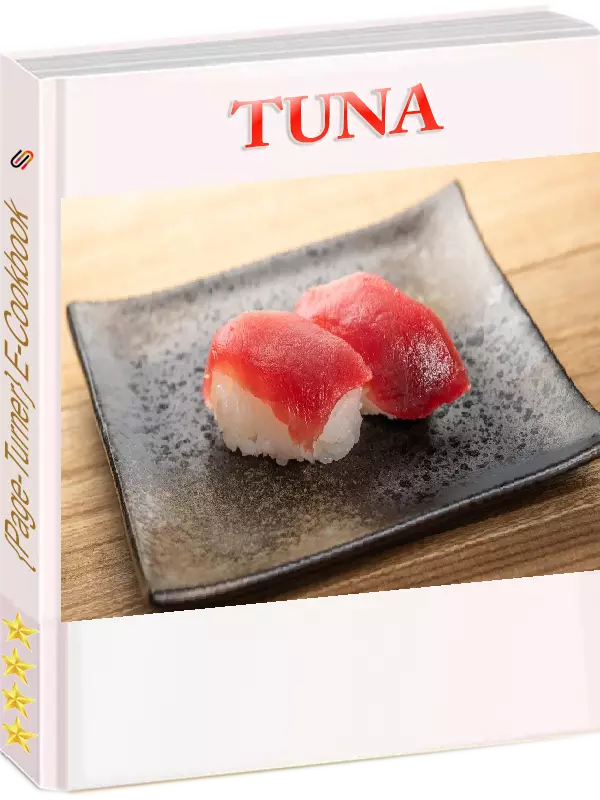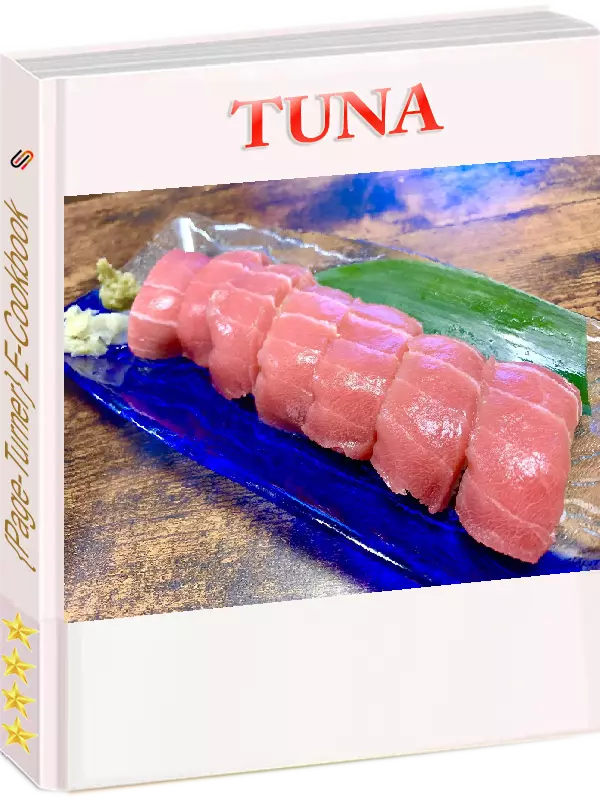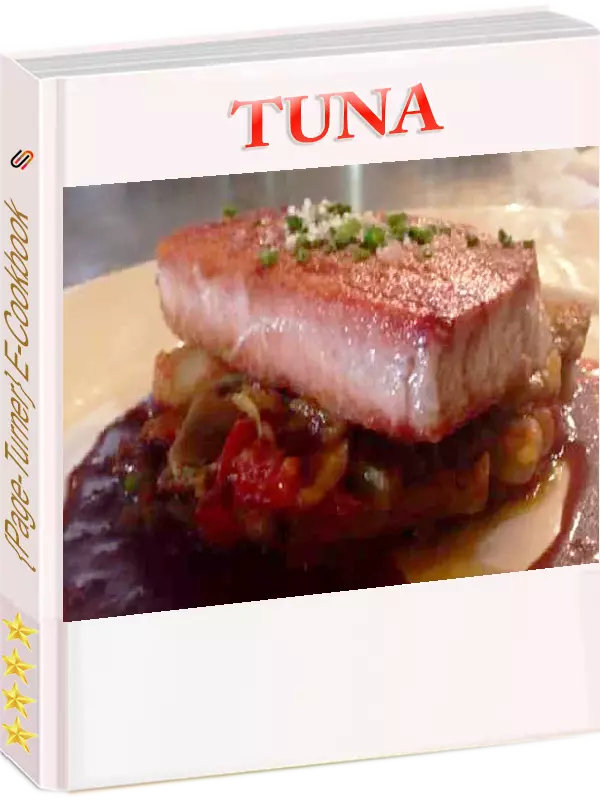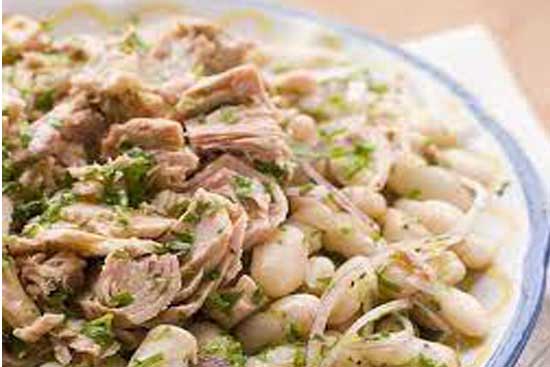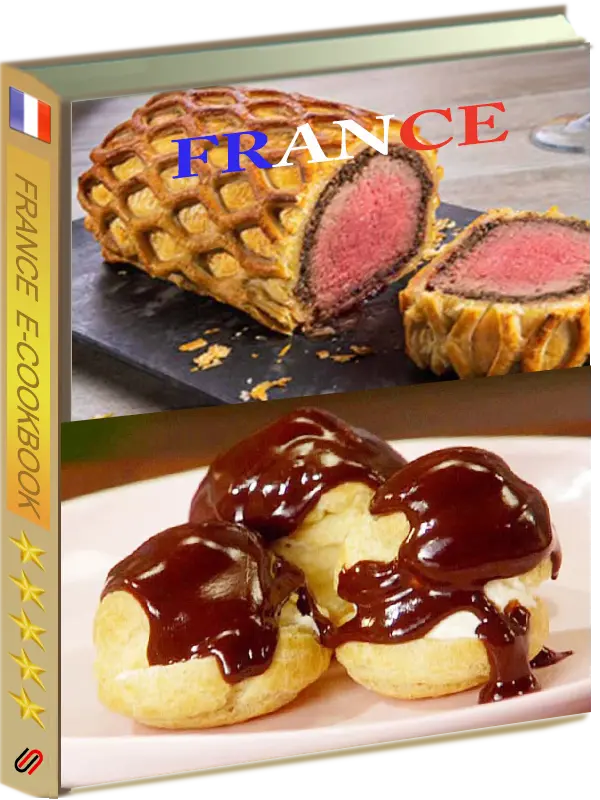If you love all things tuna
this {Pageturner Ecookbook} is for you
11 recipes
Niçoise salad
Nicoise orzo salad
Pasta and tuna with caper dressing
Pasta salad with tuna and greek olives
Seared tuna with tian of provencal vegetables
Tuna and broccoli with farfalle
Tuna and white bean salad
Tuna salad on olive bread with arugula
Tuna salad sandwich
Tuna salad sandwiches
Tuna tartare with grapefruit vinaigrette and sorbet
liquid Measures
Weight & temperature Measures
non-liquid ingredients
Top 5 countries
Last Page
Niçoise salad
Nicoise orzo salad
Pasta and tuna with caper dressing
Pasta salad with tuna and greek olives
Seared tuna with tian of provencal vegetables
Tuna and broccoli with farfalle
Tuna and white bean salad
Tuna salad on olive bread with arugula
Tuna salad sandwich
Tuna salad sandwiches
Tuna tartare with grapefruit vinaigrette and sorbet
liquid Measures
Weight & temperature Measures
non-liquid ingredients
Top 5 countries
Last Page
Types of Tuna cuts: Akami, Otoro, Chutoro, and Toro
A guide for the different cuts of Tuna (image shows Bluefin tuna)
Are you a Tuna sushi lover?
Nowadays, different types of sushi are served in restaurants. Not just in Japan but in different countries as well. And one of the best-known and most ordered sushi at restaurants in Japan is tuna sushi (known in Japan as “Maguro sushi”). What is Maguro?
Maguro (マグロ) is the Japanese term for “tuna”. The most popular species of tuna consumed in Japan is the Bluefin tuna.
Tuna is a very large fish, and when consumed in Japan, it is processed into different cuts. Each part has it’s own taste and qualities and the price varies depending on the part of the tuna.
Aomori Prefecture (青森県) is known as a leading marine area in Japan which is surrounded by four seas (the Sea of Japan, the Pacific Ocean, the Tsugaru Straits, and the Mutsu Bay). Many tuna grow in Aomori, especially the natural bluefin tuna. It is said that the Aomori tuna is the finest tuna in Japan.
Actually, until the Edo period (17th to 19th century), maguro was considered to be a low quality fish because the meat did not last long before it got bad. But with the invention of high-concentration of soy sauce, “tsukemaguro” became a huge thing and the popularity of maguro began to rise.
Now, maguro is the most commonly used fish for making sushi in Japan. Apart from sushi, maguro can be served as sashimi (fresh raw fish), and sometimes maguro sashimi is served as a donburi (a Japanese food which is the sashimi on top of a large bowl of fresh cooked rice and eaten with a little grated wasabi and dip in a soy sauce).
Many restaurants in Japan serve a variety of tuna dishes, especially seafood restaurants. And if you just want to taste different types of tuna sushi, there is a lot of sushi restaurant that only served different kind of tuna. Tuna can also be found at supermarkets or convenience stores like 7/11, family mart, etc.
In this article, when we say “types of tuna”, we refer to their cuts. And the value of tuna differ depending on the contents of fats. Here are some names of tuna cuts that describe the texture of the meat, how it taste and their value.
1. Toro (トロ)
Toro is the fatty part of the tuna, found in the belly of maguro which is the greasiest part of the abdomen. It has a soft texture and melts in your mouth. This is the more expensive part of maguro because it is rare and you can only get a small quantity. The fat in this meat contains high amounts of DHA and EPA. it is also rich in vitamin A, D and E but it is high in calories. Other than eating toro as sushi or sashimi it is also prepared made into a paste and served as a topping for gunkan sushi. This is called negitoro (ネギトロ). The Toro can be divided into two types which are “Otoro” and “Chutoro”. We will explain these two types from here on.
2. Chutoro (中トロ)
Chutoro is the belly area of maguro knowns for its medium fatty quantity. And the intermediate part between Otoro and Akami (which I will proceed to explain).
There is a meaning to this name. Chu (中) means “middle” in Japanese, and it is not too fatty nor too lean. It can be taken from the belly to the back area as well as the low part of the rear area of the tuna.
It is characterized by being moderately greasy and juicy but you also feel the meat when eating this part. The taste is similar to Akami but with a little sweetness added to it. It is not that expensive, and easy to buy at a reasonable price.
3. Otoro (大トロ) Otoro is the fattiest portion of maguro and is more expensive than chutoro. They say this is the best cut of maguro and it is mostly found in the abdomen area of the tuna.
visually, it is more white than red due to the high content of fat. When you hear “fat”, you might think it will taste greasy. But actually, because of the type of fat, this part of the tuna feels like it melts inside your mouth and it has a more sweet taste compared to the akami part.
As I mentioned before, this part of the tuna used to be thrown away until the Edo period before refrigeration was invented. These parts of the tuna spoiled faster than the meatier part, but after the invention of refrigeration, it is now considered a high-quality cut of tuna.
4. Akami (赤身)
Akami is the most common tuna sushi that is served in dining restaurants in Japan. When you see “maguro” on a menu of sushi or sashimi in a restaurant, it refers to this part.
It is known as the leaner portion of maguro with almost no fat. Its color which is red is relevant to its name “akami”, meaning “red part” in Japanese. Compared to toro, akami is found much more in quantity in the tuna fish.
Also, this part of the tuna fish is what you will usually see in supermarkets. It is low-calorie, high protein, and healthy. Since this cut is very common, it is also the cheapest part of tuna.
A guide for the different cuts of Tuna (image shows Bluefin tuna)
Are you a Tuna sushi lover?
Nowadays, different types of sushi are served in restaurants. Not just in Japan but in different countries as well. And one of the best-known and most ordered sushi at restaurants in Japan is tuna sushi (known in Japan as “Maguro sushi”). What is Maguro?
Maguro (マグロ) is the Japanese term for “tuna”. The most popular species of tuna consumed in Japan is the Bluefin tuna.
Tuna is a very large fish, and when consumed in Japan, it is processed into different cuts. Each part has it’s own taste and qualities and the price varies depending on the part of the tuna.
Aomori Prefecture (青森県) is known as a leading marine area in Japan which is surrounded by four seas (the Sea of Japan, the Pacific Ocean, the Tsugaru Straits, and the Mutsu Bay). Many tuna grow in Aomori, especially the natural bluefin tuna. It is said that the Aomori tuna is the finest tuna in Japan.
Actually, until the Edo period (17th to 19th century), maguro was considered to be a low quality fish because the meat did not last long before it got bad. But with the invention of high-concentration of soy sauce, “tsukemaguro” became a huge thing and the popularity of maguro began to rise.
Now, maguro is the most commonly used fish for making sushi in Japan. Apart from sushi, maguro can be served as sashimi (fresh raw fish), and sometimes maguro sashimi is served as a donburi (a Japanese food which is the sashimi on top of a large bowl of fresh cooked rice and eaten with a little grated wasabi and dip in a soy sauce).
Many restaurants in Japan serve a variety of tuna dishes, especially seafood restaurants. And if you just want to taste different types of tuna sushi, there is a lot of sushi restaurant that only served different kind of tuna. Tuna can also be found at supermarkets or convenience stores like 7/11, family mart, etc.
In this article, when we say “types of tuna”, we refer to their cuts. And the value of tuna differ depending on the contents of fats. Here are some names of tuna cuts that describe the texture of the meat, how it taste and their value.
1. Toro (トロ)
Toro is the fatty part of the tuna, found in the belly of maguro which is the greasiest part of the abdomen. It has a soft texture and melts in your mouth. This is the more expensive part of maguro because it is rare and you can only get a small quantity. The fat in this meat contains high amounts of DHA and EPA. it is also rich in vitamin A, D and E but it is high in calories. Other than eating toro as sushi or sashimi it is also prepared made into a paste and served as a topping for gunkan sushi. This is called negitoro (ネギトロ). The Toro can be divided into two types which are “Otoro” and “Chutoro”. We will explain these two types from here on.
2. Chutoro (中トロ)
Chutoro is the belly area of maguro knowns for its medium fatty quantity. And the intermediate part between Otoro and Akami (which I will proceed to explain).
There is a meaning to this name. Chu (中) means “middle” in Japanese, and it is not too fatty nor too lean. It can be taken from the belly to the back area as well as the low part of the rear area of the tuna.
It is characterized by being moderately greasy and juicy but you also feel the meat when eating this part. The taste is similar to Akami but with a little sweetness added to it. It is not that expensive, and easy to buy at a reasonable price.
3. Otoro (大トロ) Otoro is the fattiest portion of maguro and is more expensive than chutoro. They say this is the best cut of maguro and it is mostly found in the abdomen area of the tuna.
visually, it is more white than red due to the high content of fat. When you hear “fat”, you might think it will taste greasy. But actually, because of the type of fat, this part of the tuna feels like it melts inside your mouth and it has a more sweet taste compared to the akami part.
As I mentioned before, this part of the tuna used to be thrown away until the Edo period before refrigeration was invented. These parts of the tuna spoiled faster than the meatier part, but after the invention of refrigeration, it is now considered a high-quality cut of tuna.
4. Akami (赤身)
Akami is the most common tuna sushi that is served in dining restaurants in Japan. When you see “maguro” on a menu of sushi or sashimi in a restaurant, it refers to this part.
It is known as the leaner portion of maguro with almost no fat. Its color which is red is relevant to its name “akami”, meaning “red part” in Japanese. Compared to toro, akami is found much more in quantity in the tuna fish.
Also, this part of the tuna fish is what you will usually see in supermarkets. It is low-calorie, high protein, and healthy. Since this cut is very common, it is also the cheapest part of tuna.
Tuna are high up in the food chain. Their diet leads to the accumulation of mercury in their flesh.
The flesh of the tuna is pink to dark red. This is because tuna muscle tissue contains greater quantities of myoglobin. Myoglobin is a molecule that binds oxygen. Some of the larger tuna species such as the Northern bluefin tuna can raise their blood temperature above the water temperature with muscular activity. Yellowfin tuna is often marketed as ahi.
What kind of tuna you use for sushi?
When Japanese say tuna for sushi, it usually means, Maguro, tuna with red flesh. There are mainly three kinds of Maguro used for sushi: Bluefin , Big Eye and Yellowfin. Albacore Tuna is also used for sushi, and they are called white tuna.
Mercury levels can be relatively high in some of the larger species of tuna such as bluefin and albacore. As a result, guidelines recommend pregnant women, nursing mothers, and children to limit their intake of tuna and other types of predatory fish . Canned tuna is usually made from albacore, while fresh tuna is usually yellowfin, or bluefin. However, most canned light tuna is skipjack tuna and is very low in mercury.
The flesh of the tuna is pink to dark red. This is because tuna muscle tissue contains greater quantities of myoglobin. Myoglobin is a molecule that binds oxygen. Some of the larger tuna species such as the Northern bluefin tuna can raise their blood temperature above the water temperature with muscular activity. Yellowfin tuna is often marketed as ahi.
What kind of tuna you use for sushi?
When Japanese say tuna for sushi, it usually means, Maguro, tuna with red flesh. There are mainly three kinds of Maguro used for sushi: Bluefin , Big Eye and Yellowfin. Albacore Tuna is also used for sushi, and they are called white tuna.
Mercury levels can be relatively high in some of the larger species of tuna such as bluefin and albacore. As a result, guidelines recommend pregnant women, nursing mothers, and children to limit their intake of tuna and other types of predatory fish . Canned tuna is usually made from albacore, while fresh tuna is usually yellowfin, or bluefin. However, most canned light tuna is skipjack tuna and is very low in mercury.
Niçoise salad 
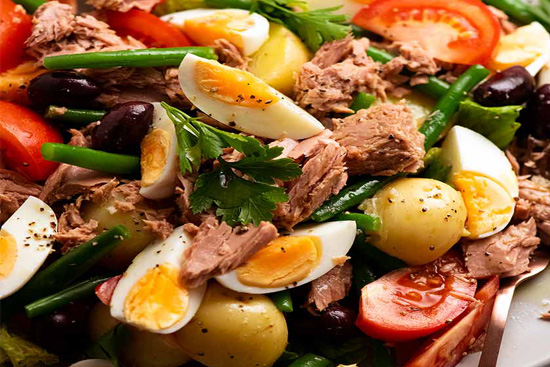
Serves: 2
Preparation time:20 minutes
Cooking time:15 minutes
Tomatoes, Broad beans and/or small purple artichokes hearts, green Onions or radishes, local summer peppers, Basil, Anchovy, Nice black olives (small and specific to the region), Olive oil, Garlic, Salt pepper
For the Dressing
3 tablespoons white wine vinegar
1-1/2 teaspoons Dijon mustard
1/8 teaspoon onion powder
1/8 teaspoon salt
1/8 teaspoon ground black pepper
1/3 cup olive oil
For the Salad
2 small red potatoes
1/2 cup cut fresh green beans
3-1/2 cups torn Bibb lettuce, washed and spun dry
1/2 cup cherry tomatoes, halved or a summer red tomato, cut into small wedges
10 Nicoise olives, pitted
2 hard-boiled large eggs, quartered
1 (5-ounce) can albacore, drained and flaked
To make the dressing, combine the white wine vinegar, Dijon mustard, onion powder, salt and pepper in a small bowl. Add the olive oil in a slow, steady stream, whisking as you go. Set the dressing aside.
Cook the vegetables on the stovetop. For the potatoes, place the whole red potatoes in a small saucepan and cover them with cold water. Bring the water to a boil. Then, reduce the heat to a simmer and cover the pot. Cook until the potatoes are tender, about 15 to 20 minutes. Drain and discard the cooking water and let the potatoes cool before cutting them into quarters.
For the green beans, blanching is best. Bring a small saucepan of salted water to a boil. When the water is boiling, add the green beans and cook for about 3 minutes, until they’re tender-crisp. Remove the beans to a bowl of ice water to cool them down.
Divide the lettuce between two salad bowls. Top each plate with half of the potatoes, beans, tomatoes, olives, hard-boiled eggs and . Drizzle the salads with dressing and serve any extra dressing on the side.
Chef's notes:
The 19th century century Niçoise salad recipe as it is kept in the archives in Nice, France consists of local ingredients:
Tomatoes, Broad beans and/or small purple artichokes hearts, green Onions or radishes, local summer peppers, Basil, Anchovy, Nice black olives (small and specific to the region), Olive oil, Garlic, Salt pepper
If we want to respect in an orthodox way the model of the Nicoise salad, we should not add anything more. Forget about the grilled , it was a rich thing back then, nobody ate that. You'll also notice there's no egg: at that time, the Nicoise salad was really all raw - or at least, as far as anchovies and olives go, fermented, but not cooked.
Dressing the salad: Traditionally, the Niçoise salad is laid out flat, so that all the ingredients are visible and well distributed. You should therefore take a large, slightly deep plate rather than a salad bowl.
The local garlic, which is pink, will be used to rub the plate to flavor it. Do not put the minced garlic cloves directly in the salad, it would be too strong. Place the tomatoes in quarters first, then add all the other ingredients on top and drizzle with a little olive oil (and red wine vinegar if you like). A little salt if necessary and a turn of the pepper mill, a few chopped basil leaves, and it's ready.
Nowadays, Niçoise salad has become a mix of various colorful ingredients consisting of potatoes, black olives, green beans, artichokes hearts, green onions, radishes, cucumbers, peppers, anchovies and vinaigrette dressing. Hard boiled eggs , , (canned or fresh broiled and sliced) , grilled salmon pieces, or chicken are often the main proteins in the recipe.
Some people say the salad is served on a bed of lettuce and others say that tomatoes are the base. And some do not arrange the elements of the salad at all, but just toss it all together.
Nicoise orzo salad 
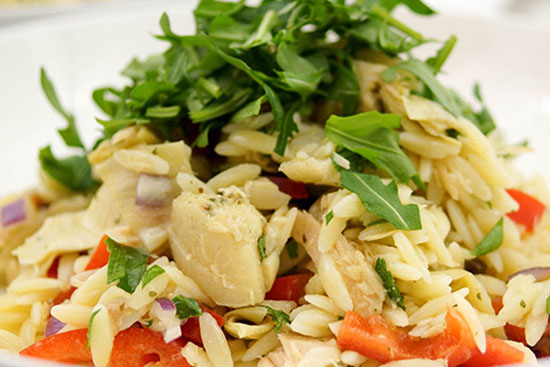
Serves: 4
Preparation time: 20 minutes
Cooking time:25 minutes
1 cup long grain orzo
1/2 pound green beans cut into 1/2-inch pieces
For dressing:
3 teaspoons red wine vinegar
1 teaspoon lemon juice
4 anchovy fillets, chopped
1 teaspoon dijon mustard
1 garlic clove, minced
1/3 cup virgin olive oil
1/4 teaspoon ground black pepper
6 ounce jar artichoke hearts, drained and chopped
7 ounce can , drained, flaked
1 red bell pepper, chopped
1/2 cup chopped red onion
1 1/2 teaspoons minced fresh thyme leaves
1/3 cup kalamata or brined-cured black olives, chopped
2 cups chopped arugala, washed and spun dry
Cook orzo in salted boiling water until tender. Drain in a colander, and rinse under cold water. Drain again.
Transfer to a large bowl. Cook beans in salted boiling water until crisp-tender. Cool and drain. Add to orzo.
In a blender, combine Red wine vinegar, Lemon juice, anchovy fillets, Dijon mustard, garlic clove, olive oil, and pepper. Blend until dressing is smooth. Add dressing to orzo mixture. Blend in the remaining ingredients. Serve as a main course.
Pasta and tuna with caper dressing 

Serves: 6
Preparation time: 15 minutes
Cooking time:20 minutes
12 ounces pasta shells
8 ounces can white
1 medium red pepper, thinly sliced
8 ounces broccoli florets
1/2 cup grated parmesan
1/4 cup shredded basil
For caper dressing:
1/2 cup olive oil
3 teaspoons red wine vinegar
2 teaspoons drained capers
1 teaspoon dried oregano
2 cloves minced garlic
3/4 teaspoon salt
1/4 teaspoon ground white pepper Cook pasta until al dente, drain, rinse under cold water until chilled, drain well.
Drop broccoli florets into boiling salted water and cook for 2 minutes. Drain and rinse under cold water to stop the cooking; drain well again. Flake the .
Combine with pasta, broccoli and pepper. Blend in dressing and remaining ingredients.
Season to taste with salt and pepper.
Caper dressing :
Combine all ingredients in a mixing bowl. Stir to blend
Pasta salad with tuna and greek olives 

Serves: 6
Preparation time: 10 minutes
Cooking time:12 minutes
12 ounces rigatoni, penne, or other short pasta
1 7-ounce can in oil, preferably olive, drained
1/2 pound large black greek olives in brine, drained
1/2 pound cherry tomatoes, cut in half
1/2 cup olive oil
4 teaspoons fresh lemon juice
2 teaspoons drained capers
salt and pepper to taste Cook pasta in salted boiling water until al dente.
Drain, rinse under cold water until chilled, drain well and toss with one tablespoon oil.
Pit and chop olives; break into chunks. Put olives, , capers, lemon juice, and olive oil into small bowl. Season with salt and pepper to taste. Mix well.
In large serving bowl, toss pasta, and oil mixture, and tomatoes. Adjust seasonings. Cover and refrigerate until ready to serve.
Seared tuna with tian of provencal vegetables 
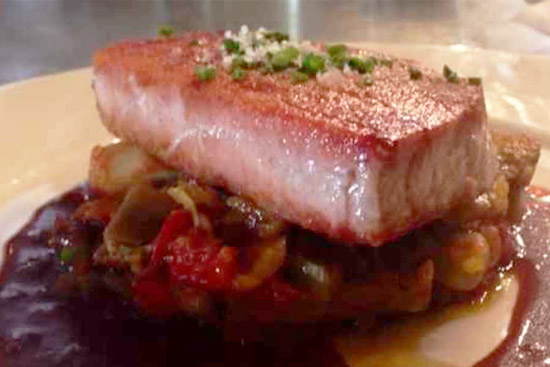
Serves: 6
Preparation time: 1 hour
Cooking time:3 hours
Vegetable Tian:
1/3 cup extra-virgin olive oil
1 teaspoon chopped fresh thyme
1/4 teaspoon minced garlic
1 1/2 teaspoons fine sea salt
1/4 teaspoon freshly ground black pepper
1 pound red bell peppers, roasted, peeled, seeded, and sliced into 1-inch wide strips
12 ounces fresh plum tomatoes, cut into 1/8-inch thick rounds
8 ounces zucchini, cut into 1/8-inch thick rounds
8 ounces Japanese eggplant, cut into 1/8-inch thick rounds
Assembly:
6 (6-ounce) portions fresh steaks, cut about 2 1/2-inches thick
1/2 teaspoon fine sea salt
1/4 teaspoon freshly ground black pepper
1 tablespoon extra-virgin olive oil Preheat the oven to 350 degrees F. Lightly oil a 9 by 13-inch ceramic or glass baking dish. In a small bowl, combine the oil with the thyme, garlic, salt, and pepper.
Arrange half of the vegetables in rows in the dish, interspersing the different types until the bottom of the dish is covered. Drizzle with half of the oil mixture.
Make a final layer of mixed vegetables, and drizzle with the remaining oil mixture. Cover the top of the vegetables with lightly oiled parchment paper. Bake until the vegetables are tender, about 40 minutes.
Remove the vegetable tian from the oven, keep warm in a warm place, and increase the oven temperature to 450 degrees F.
Season the with the salt and pepper. Heat the oil in a large nonstick skillet over high heat. Add the and cook, turning once, until seared on both sides, about 2 minutes.
Uncover the tian and place the seared fillets on top of the vegetables, spacing them evenly. Bake, uncovered, until the is rare to medium-rare, about 5 minutes. Spoon equal amounts of the sauce in the centers of 6 warmed plates.
Using a wide spatula, lift portions of the and vegetables and transfer to the plates.
Tomato Confit:
1 pound ripe plum tomatoes, peeled, halved, and squeezed to remove seeds 1 teaspoon fine sea salt 6 garlic cloves, peeled 2 (3-inch ) sprigs fresh rosemary 1 1/2 cups olive oil, or as needed
Garlic Confit:
1 cup whole, peeled garlic cloves 1 cup olive oil, plus more as needed Place the tomatoes in a colander and toss with the salt. Let drain at room temperature for 2 hours. Pat the tomatoes dry with paper towels. Preheat the oven to 250 degrees F.
Place the tomatoes, garlic, and rosemary in a nonreactive 2-quart saucepan. Add enough oil to cover the tomatoes. Cover the saucepan and bake until the tomatoes are very tender, but not falling apart, about 3 hours. Drain, discard the garlic and rosemary, and set the tomato confit aside for the sauce. (The tomato confit can be prepared up to 3 days in advance, covered and refrigerated.)
Place the garlic cloves and 2 cups cold water in a small saucepan and bring to a boil over high heat. Drain. Repeat the procedure 2 more times. Return the drained garlic cloves to the saucepan and add the oil. Bring to a bare simmer over very low heat. Cook until the garlic is tender, about 40 minutes. Cool completely.
Transfer to a 1-pint canning jar, add enough oil to cover the garlic, and seal. (The garlic confit can be prepared up to 3 weeks in advance, covered and refrigerated.)
Sauce:
1/2 cup Tomato Confit (see above)
1/3 cup Garlic Confit (see above)
1/3 cup water
1/2 teaspoon fine sea salt
1/8 teaspoon freshly ground pepper
2 tablespoons extra-virgin olive oil
3 tablespoons chopped fresh parsley
1 teaspoon chopped fresh thyme
Place the tomato confit, garlic confit, water, salt and pepper in a blender and process on high speed. With the machine running, drizzle in the oil and blend until the sauce is emulsified, about 1 minute. Transfer to a medium bowl and stir in the parsley and thyme. Set aside at room temperature.
Recipe courtesy Terrance Brennan
Tuna and broccoli with farfalle 

Serves: 6
Preparation time: 20 minutes
Cooking time:10-15 minutes
8 ounces farfalle (bow ties)
1 bunch broccoli
4 red pepers, cut into 1 inch squares
2 7-1/2 ounces cans solid white in oil, drained and broken into large chunks
1 cup italian olives or other cured green olives
Dressing:
1/2 cup olive oil
3 teaspoons red wine vinegar
2 teaspoons capers, drained
1 teaspoon oregano, chopped
2 cloves garlic, minced
3/4 teaspoon salt
1/4 teaspoon ground pepper
Cook pasta until al dente. Drain, rinse with cold water, drain again and transfer to a large shallow bowl. Toss with 2 tablespoons olive oil.
Cut broccoli stems from florets. Peel and slice into 1/2 inch pieces. Divide florets into approximately 1 inch pieces.
Cook stems in boiling salted water about 5 minutes.
Cook florets in boiling salted water about 3 minutes. Drain broth, rinse with cold water and drain again. Gently pat dry with paper towels. Toss florets only with 1/4 cup dressing and chill; reserve. Add the broccoli stems, peppers, olives and to the pasta and toss gently with the remaining dressing. Cover and chill at least 2 hours before serving. Make a border with the broccoli florets before bringing to the table.
Tuna and white bean salad 
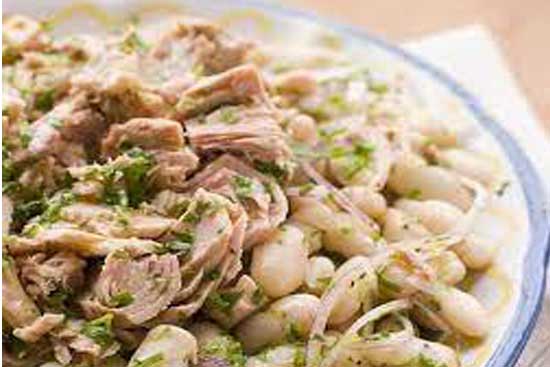
Serves: 4
Preparation time: 15 minutes
or
Mix with pasta and green beans for a spin on Pasta Nicoise
1 can (15 to 15 ½ ounces) white cannellini beans,
rinsed, drained
1/2 cup thinly sliced red onion, halved
1 can (6 ounces) in olive oil (drain; reserve oil)
1 cup diced plum tomatoes
1/2 cup pitted Kalamata olives
2 tablespoons chopped Italian parsley
1 tablespoon lemon juice
½ teaspoon grated lemon zest
¼ teaspoon each salt and freshly ground black pepper
2 cups torn arugula leaves
4 thick flatbreads 1. In a bowl, combine cannellini beans, red onion, , tomatoes, olives, chopped parsley, 2 tablespoons of the reserved olive oil, lemon juice, lemon zest, salt, and pepper, tossing gently to combine. Stir in arugula.
2. Preheat grill or heat grill pan. Brush flatbreads lightly with the remaining reserved olive oil. Grill until lightly browned, about 2 minutes per side. Cut flatbreads in halves or quarters. Serve with salad.
Each serving contains about 480 calories, 31 grams of protein, 51 grams of carbohydrate, 16 grams of total fat (3 grams saturated), 7 grams of fiber, 27 milligrams of cholesterol, and 1,273 milligrams of sodium.
Tuna salad on olive bread with arugula 
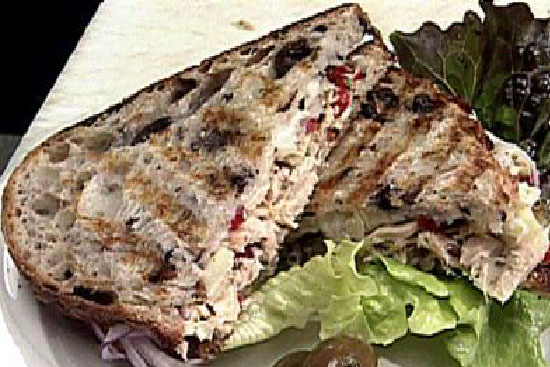
Serves: 6
Preparation time: 20 minutes
2 6-ounce packages albacore packed in water, drained
3/4 cup mayonnaise
1/2 cup chopped green onions
1/4 cup diced seeded English hothouse cucumber
1/4 cup minced fresh dill
1/4 cup drained capers
2 tablespoons Dijon mustard
2 tablespoons minced fresh tarragon
12 1/3-inch-thick slices olive bread
1 cup arugula
Mix , 1/4 cup mayonnaise, and next 6 ingredients in medium bowl to blend. Season with salt and pepper. Divide salad among 6 bread slices; top with arugula leaves.
Spread remaining mayonnaise on remaining 6 bread slices; place atop arugula.
Cut sandwiches in half; wrap each tightly in plastic wrap.
Can be made 1 day ahead. Refrigerate.
Tuna salad sandwich 
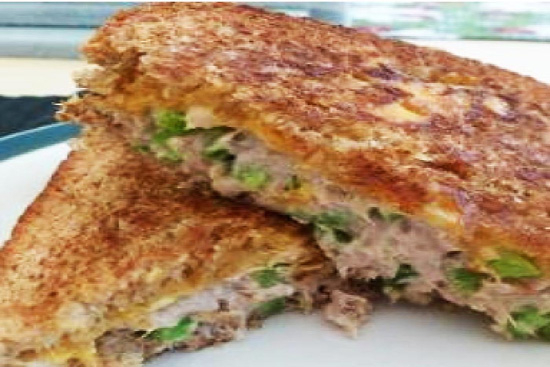
Serves: 6
Preparation time:15 minutes
Can be made 1 day ahead. Refrigerate.
2 6-ounce packages albacore packed in water, drained
1/4 cup mayonnaise
1/2 cup chopped green onions
1/4 cup diced seeded English hothouse cucumber
1/4 cup minced fresh dill
1/4 cup drained capers
2 tablespoons Dijon mustard
2 tablespoons minced fresh tarragon Mix , 1/4 cup mayonnaise, and next 6 ingredients in medium bowl to blend. Season with salt and pepper.
Tuna salad sandwiches 
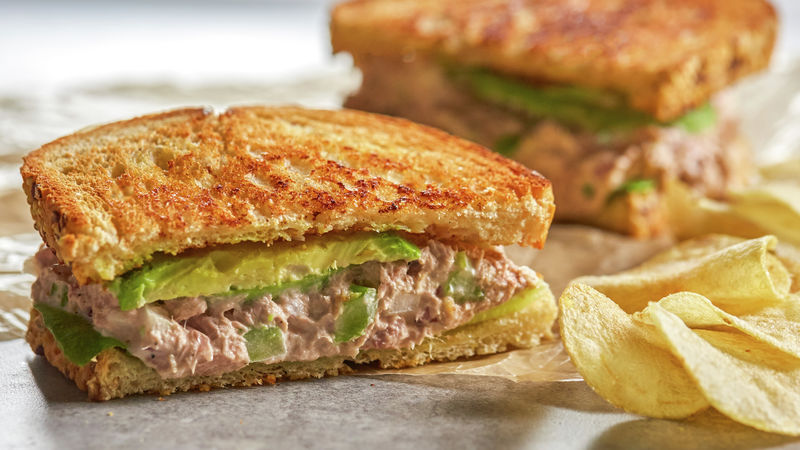
Serves: 4
Preparation time:15 minutes
Mayonnaise, lemon juice or vinegar and seasonings.
Stuff tuna salad in hollowed out tomatoes or avocado halves for a fresh take on lunch.
Swap out the tuna for chicken or ham, adding some Dijon mustard with the mayonnaise in the dressing.
2 cans (6 oz each) in water, drained
1/2 cup chopped celery
1/4 cup chopped green onion
1/2 cup mayonnaise
1 teaspoon lemon juice
1/4 teaspoon salt
1/4 teaspoon pepper
8 slices bread In a medium bowl, mix the , celery, onion, mayonnaise, lemon juice, salt and pepper.
Spread mixture on 4 bread slices, toasted or plain. Top with remaining bread slices.
Tuna tartare with grapefruit vinaigrette and sorbet 

Serves: 4
Preparation time: 1 hour
I think the citrus tang tastes best in summer, but you can use this recipe year-round, as long as the tuna you buy is the very best quality available.
grapefruit sorbet:
1/2 cup fresh-squeezed grapefruit juice
1/2 cup water
1/2 cup ginger, minced (if you can find the pickled variety, use that)
1/4 cup sugar
1 Tablespoons horseradish
grapefruit vinaigrette:
4 large grapefruit segments
4 Tablespoons fresh cilantro leaves
1 Tablespoon ginger, minced (again, try to find pickled)
1 Tablespoon champagne vinegar
1 jalapeno, minced
1/4 Teaspoon horseradish
For the tartare:
3/4 pounds
2 Tablespoons extra virgin olive oil
Pinch of salt Make grapefruit sorbet:
Combine all ingredients in an ice cream maker and process until firm.
Make grapefruit vinaigrette:
Crush grapefruit segments, then add other ingredients, including salt and pepper to taste.
For the tartare:
Chop the coarsely, then, in a chilled metal bowl, combine it with the oil and salt.
To Assemble:
Pour the grapefruit vinaigrette over the , toss lightly, and mold the mixture onto the center of a plate.
At Mantra, we garnish the plate with cucumbers in yogurt and marinated radishes, but feel free to add any cold salad fixings.Top with a melon ball-sized scoop of sorbet.
For an upscale touch, put a teaspoon of osetra caviar on top to finish.
conversion of liquids
Weights
Temperatures
Measures of non liquid ingredients
Non-liquid ingredients in volume converted
|
|||||||
|---|---|---|---|---|---|---|---|
Ingredient |
1 cup |
3/4 cup |
2/3 cup |
1/2 cup |
1/3 cup |
1/4 cup |
2 tablespoons |
| All-purpose wheat flour | 120 g | 90 g | 80 g | 60 g | 40 g | 30 g | 15 g |
| All-purpose sifted wheat flour | 110 g | 80 g | 70 g | 55 g | 35 g | 27 g | 13 g |
| White sugar | 200 g | 150 g | 130 g | 100 g | 65 g | 50 g | 25 g |
| Powdered sugar/Icing sugar | 100 g | 75 g | 70 g | 50 g | 35 g | 25 g | 13 g |
| Brown sugar normally packed | 180 g | 135 g | 120 g | 90 g | 60 g | 45 g | 23 g |
| Corn flour | 160 g | 120 g | 100 g | 80 g | 50 g | 40 g | 20 g |
| Cornstarch | 120 g | 90 g | 80 g | 60 g | 40 g | 30 g | 15 g |
| Rice (not-cooked) | 190 g | 140 g | 125 g | 95 g | 65 g | 48 g | 24 g |
| Macaroni (uncooked) | 140 g | 100 g | 90 g | 70 g | 45 g | 35 g | 17 g |
| Couscous (uncooked) | 180 g | 135 g | 120 g | 90 g | 60 g | 45 g | 22 g |
| Quick oatmeal (uncooked) | 90 g | 65 g | 60 g | 45 g | 30 g | 22 g | 11 g |
| Table salt | 300 g | 230 g | 200 g | 150 g | 100 g | 75 g | 40 g |
| Butter / Margarine | 240 g | 180 g | 160 g | 120 g | 80 g | 60 g | 30 g |
| Shortening | 190 g | 140 g | 125 g | 95 g | 65 g | 48 g | 24 g |
| Fruits and légumes chopped | 150 g | 110 g | 100 g | 75 g | 50 g | 40 g | 20 g |
| chopped walnuts | 150 g | 110 g | 100 g | 75 g | 50 g | 40 g | 20 g |
| Nuts /ground almonds | 120 g | 90 g | 80 g | 60 g | 40 g | 30 g | 15 g |
| Fresh bread crumbs (not packed) | 60 g | 45 g | 40 g | 30 g | 20 g | 15 g | 8 g |
| Dry bread crumbs | 150 g | 110 g | 100 g | 75 g | 50 g | 40 g | 20 g |
| Parmesan grated | 90 g | 65 g | 60 g | 45 g | 30 g | 22 g | 11 g |
| Chocolate chips | 150 g | 110 g | 100 g | 75 g | 50 g | 38 g | 19 g |
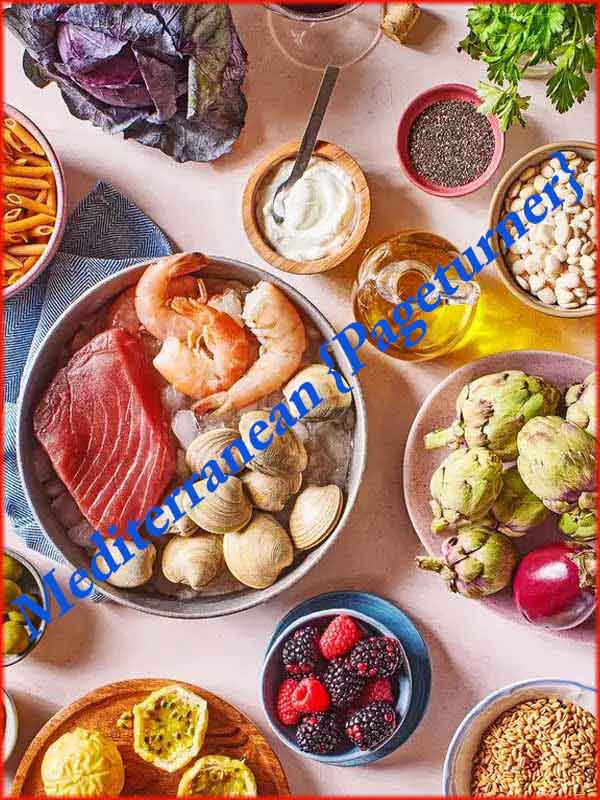
Last page
tuna
{Page-Turner} E-Cookbooks Library
on a world cooking journey.
11 Recipes
tuna recipes

